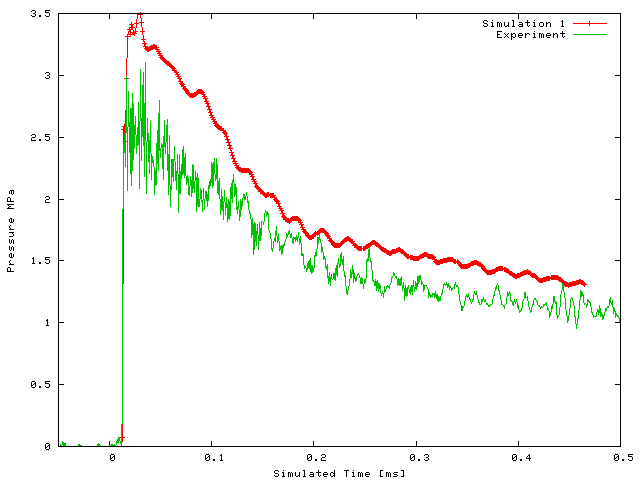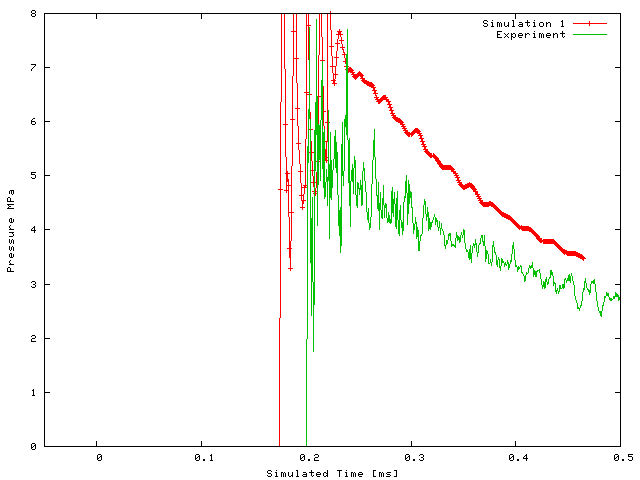Start of topic | Skip to actions
Coupled Solver Validation for Plastic Flap Opening
Flaps hinge back freely
Simulated and actual schlieren images show good agreement at earlier times, but the solid material is too stiff and not sufficiently plastic. The flap springs back after about 300 micro-seconds, which is not in qualitative agreement with the experiment. A detailed comparison of computational and experimental schlieren images can be found on a separate page.- An animation of the simulated schlieren images showing also the shadow of the opening flaps is available: Simulated schlieren images at x=0.0m with flap deformation
- Further animations visualizing particular the fluid flow are available:
- Animations of dynamic fluid mesh adaptation
- Animation of distribution of computational domain to processors in fluid
 |  |
| z=0.444m (overall distance 1.964m) | z=0.896m, (overall distance 2.416m) |
- Fluid
- gamma=1.24, p0=100 kPa
- Van Leer flux vector splitting with 2nd order MUSCL reconstruction, dimensional splitting
- CJ volume burn model
- Computational domain: [-0.39m,0.39m]x[-0.0375m,0.5625m]x[-0.9200m,0.8960m]
- AMR base level: 104x80x242, 3 additional levels, refinement factor 2,2,4
- Equivalent unigrid run 7,929,856,000 cells
- Approx. 40,000,000 cells used in fluid on average
- Tube and detonation fully refined
- No refinement for z<0 (to approximate Taylor wave)
- No maximal refinement for x<-0.1575m, x>0.1575m, y>0.15m
- Thickening of 2d mesh: 0.81mm on both sides (real thickness on both sides 0.445mm)
- 16 nodes 2.2 GHz AMD Opteron quad processor, PCI-X 4x Infiniband network
- Solid
- Aluminium, J2 plasticity model
- Specimen from z=0 to z=0.896m, middle axis along z-axis
- Middle of slot at x=0.0m, y=0.020195m, z=0.444m
- Mesh: 8577 nodes, 17056 elements
- Close-up of slot in solid mesh
- 2 nodes 2.2 GHz AMD Opteron quad processor, PCI-X 4x Infiniband network
- The flaps are allowed to hinge back freely. No nodes on mesh constrained. This causes convergence problems because of mesh distortions at approx. t=460micro-seconds.
- Ca. 4320h CPU to t=450 micro-seconds
- Source code: [fluid codes] [solid codes]
-- RalfDeiterding - 13 Feb 2006
| I | Attachment  | Size | Date | Who | Comment |
|---|---|---|---|---|---|
| | FlapsDenCutX.mpg | 1250.1 K | 14 Feb 2006 - 01:50 | RalfDeiterding | Color plot of density, displacement in y-direction |
| | FlapsDensity.mpg | 1547.3 K | 14 Feb 2006 - 01:50 | RalfDeiterding | Color plot of density at x=0, z=0.444m |
| | FlapsLevSl.mpg | 1755.0 K | 14 Feb 2006 - 01:51 | RalfDeiterding | Schlieren plot of density on refinement levels at x=0, z=0.444m, part of deforming solid mesh |
| | FlapsLevCutX.mpg | 967.4 K | 14 Feb 2006 - 01:52 | RalfDeiterding | Schlieren plot of density on refinement levels, x=0 |
| | FlapsLevCutZ.mpg | 770.9 K | 14 Feb 2006 - 01:53 | RalfDeiterding | Schlieren plot of density on refinement levels, z=0.444m |
| | FlapsSchlCutX.mpg | 658.5 K | 14 Feb 2006 - 01:55 | RalfDeiterding | Schlieren plot of density at x=0, corresponds to experimental schlieren images |
| | FlapsDist.mpg | 1906.4 K | 14 Feb 2006 - 04:55 | RalfDeiterding | Distribution to processors in fluid |